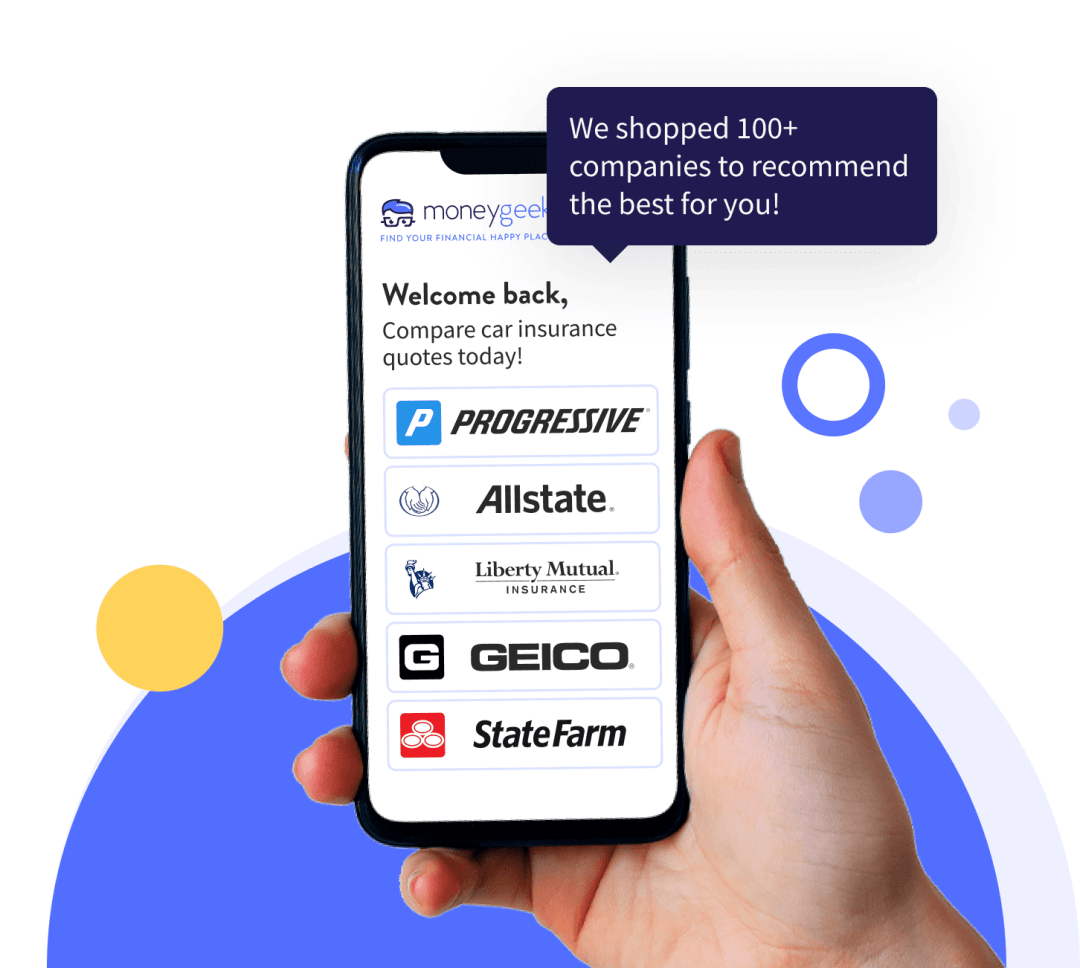State minimum car insurance requirements, including the type and coverage limits, vary by state based on each state's insurance laws and financial responsibility requirements. Find your state's requirements instantly using the table below.
State Minimum Car Insurance Requirements (2025)
All states (except New Hampshire) require drivers to carry at least liability coverage to meet state minimum car insurance requirements; limits vary by state.
Find out if you're overpaying for car insurance below.

Updated: November 12, 2025
Advertising & Editorial Disclosure
Depending on the state, minimum car insurance requirements may include bodily injury liability, property damage liability, uninsured/underinsured motorist and personal injury protection coverage.
The average annual cost of state-required minimum coverage is $959, compared to $1,895 for full coverage policies with higher limits.
While minimum coverage is the cheapest insurance you can buy, it may not cover all your expenses after an accident.
Ensure you are getting the best rate for your insurance. Compare quotes from the top insurance companies.
Minimum Car Insurance Requirements by State
State | Bodily injury liability (per person) | Bodily injury liability (per accident) | Property damage liability (per accident) | Other car insurance requirements |
|---|---|---|---|---|
Alabama | $25,000 | $50,000 | $25,000 | None |
Alaska | $50,000 | $100,000 | $25,000 | None |
Arizona | $25,000 | $50,000 | $15,000 | None |
Arkansas | $25,000 | $50,000 | $25,000 | None |
California | $30,000 | $60,000 | $15,000 | None |
Colorado | $25,000 | $50,000 | $15,000 | None |
Connecticut | $25,000 | $50,000 | $25,000 | Uninsured/underinsured motorist bodily injury: $25,000 per person $50,000 per accident |
Delaware | $25,000 | $50,000 | $10,000 | Personal injury protection: $15,000 per person $30,000 per accident |
District of Columbia | $25,000 | $50,000 | $10,000 | Uninsured/underinsured motorist bodily injury: $25,000 per person $50,000 per accident Uninsured/underinsured property damage: $5,000 (subject to $200 deductible) |
Florida | $10,000 | $20,000 | $10,000 | Personal injury protection: $10,000 |
Georgia | $25,000 | $50,000 | $25,000 | None |
Hawaii | $20,000 | $40,000 | $10,000 | Personal injury protection: $10,000 |
Idaho | $25,000 | $50,000 | $15,000 | None |
Illinois | $25,000 | $50,000 | $20,000 | Uninsured motorist bodily injury: $25,000 per person $50,000 per accident |
Indiana | $25,000 | $50,000 | $25,000 | None |
Iowa | $20,000 | $40,000 | $15,000 | None |
Kansas | $25,000 | $50,000 | $25,000 | Personal injury protection: $4,500 Uninsured/underinsured motorist bodily injury: $25,000 per person $50,000 per accident |
Kentucky | $25,000 | $50,000 | $25,000 | Personal injury protection: $10,000 |
Louisiana | $15,000 | $30,000 | $25,000 | None |
Maine | $50,000 | $100,000 | $25,000 | Medical payments: $2,000 Uninsured/underinsured motorist bodily injury: $50,000 per person $100,000 per accident |
Maryland | $30,000 | $60,000 | $15,000 | Personal injury protection: $2,500 Uninsured/underinsured motorist bodily injury: $30,000 per person $60,000 per accident Uninsured motorist property damage: $15,000 |
Massachusetts | $20,000 | $40,000 | $5,000 | Personal injury protection: $8,000 per accident Uninsured/underinsured motorist bodily injury: $20,000 per person $40,000 per accident |
Michigan | $20,000 | $40,000 | $10,000 (for damage your vehicle does to property in another state) | Personal injury protection: Unlimited per person Unlimited per accident Property protection: $1 million |
Minnesota | $30,000 | $60,000 | $10,000 | Personal injury protection: $40,000 per person Uninsured/underinsured motorist bodily injury: $25,000 per person $50,000 per accident |
Mississippi | $25,000 | $50,000 | $25,000 | None |
Missouri | $25,000 | $50,000 | $25,000 | Uninsured/underinsured motorist bodily injury: $25,000 per person $50,000 per accident |
Montana | $25,000 | $50,000 | $20,000 | None |
Nebraska | $25,000 | $50,000 | $25,000 | Uninsured/underinsured motorist bodily injury: $25,000 per person $50,000 per accident |
Nevada | $25,000 | $50,000 | $20,000 | None |
New Hampshire | $25,000 | $50,000 | $25,000 | Uninsured/underinsured motorist bodily injury: $25,000 per person $50,000 per accident |
New Jersey | $15,000 | $15,000 | $5,000 | None |
New Mexico | $25,000 | $50,000 | $10,000 | None |
New York | $25,000 | $50,000 | $10,000 | Personal injury protection: $50,000 per person Liability for death: $50,000 per person Uninsured/underinsured motorist bodily injury: $25,000 per person $50,000 per accident |
North Carolina | $30,000 | $60,000 | $25,000 | Uninsured/underinsured motorist bodily injury: $30,000 per person $60,000 per accident Uninsured/underinsured motorist property damage: $25,000 |
North Dakota | $25,000 | $50,000 | $25,000 | Personal injury protection: $30,000 per person Uninsured/underinsured motorist bodily injury: $25,000 per person $50,000 per accident |
Ohio | $25,000 | $50,000 | $25,000 | None |
Oklahoma | $25,000 | $50,000 | $25,000 | None |
Oregon | $25,000 | $50,000 | $20,000 | Uninsured/underinsured motorist bodily injury: $25,000 per person $50,000 per accident |
Pennsylvania | $15,000 | $30,000 | $5,000 | Medical payments coverage: $5,000 |
Rhode Island | $25,000 | $50,000 | $25,000 *or $75,000 combined single limit | None |
South Carolina | $25,000 | $50,000 | $25,000 | Uninsured/underinsured motorist bodily injury: $25,000 per person $50,000 per accident |
South Dakota | $25,000 | $50,000 | $25,000 | Uninsured/underinsured motorist bodily injury: $25,000 per person $50,000 per accident |
Tennessee | $25,000 | $50,000 | $15,000 | None |
Texas | $30,000 | $60,000 | $25,000 | None |
Utah | $30,000 | $65,000 | $25,000 | Personal injury protection: $3,000 per person Uninsured motorist coverage: $30,000 per person $65,000 per accident |
Vermont | $25,000 | $50,000 | $10,000 | Uninsured/underinsured motorist bodily injury: $50,000 per person $100,000 per accident Uninsured/underinsured property damage: $10,000 |
Virginia | $50,000 | $100,000 | $25,000 | None |
Washington | $25,000 | $50,000 | $10,000 | None |
West Virginia | $25,000 | $50,000 | $25,000 | Uninsured/underinsured motorist bodily injury: $25,000 per person $50,000 per accident |
Wisconsin | $25,000 | $50,000 | $10,000 | Uninsured/underinsured motorist bodily injury: $25,000 per person $50,000 per accident |
Wyoming | $25,000 | $50,000 | $20,000 | None |
*The minimum coverage types and limits above apply separately to each accident. Once reached, your insurance company pays nothing more. If you cause $100,000 in damages but have only $50,000 in coverage, you're personally liable for the remaining $50,000.
What State Does Not Require Car Insurance?
In New Hampshire, buying car insurance is optional, but drivers must prove they can cover damages if they cause an accident. Drivers who choose to get coverage must meet New Hampshire's state minimum requirements:
- $25,000 for bodily injury per person
- $50,000 per accident
- $25,000 for property damage
- Uninsured/underinsured motorist coverage matching liability limits
- At least $1,000 in medical payments coverage
State Minimum Coverage Requirements Explained
Every state has its own laws mandating state minimum car insurance, and each state determines which types of coverage and policy limits are required. Understanding what these different coverage options actually do helps you stay on the right side of the law and figure out how much financial protection makes sense for your situation.
- Bodily Injury Liability: Medical expenses, lost wages, pain and suffering when you injure someone
- Property Damage Liability: Repair/replacement costs for other people's vehicles and property
- Uninsured Motorist: For drivers with no insurance
- Underinsured Motorist: For drivers whose coverage is insufficient
- 80% of medical costs up to policy limit
- Percentage of lost wages
- Essential services (childcare, housekeeping)
- Rehabilitation expenses
- Lower coverage limits ($1,000 to $10,000)
- Covers only medical and funeral expenses
- No lost wages or other benefits
- Supplements health insurance
Liability insurance forms the foundation of state minimum car insurance in all states except New Hampshire.
What it covers: Pays for damage you cause to other people and their property
*Required in all states except New Hampshire
What it covers: Protects you when hit by a driver with no insurance or insufficient coverage
Coverage amounts: Usually match your state's minimum liability requirements
*Required in 22 states
Personal injury protection coverage is required as part of state minimum car insurance in 12 no-fault states: Delaware, Florida, Hawaii, Kansas, Kentucky, Maryland, Massachusetts, Michigan, Minnesota, New York, North Dakota and Utah.
What it covers: Your own medical expenses and lost wages, regardless of who caused the accident
Typical benefits:
What it covers: Medical expenses from car accidents regardless of fault
Key differences from PIP:
*Required in three states: Maine, New Hampshire and Pennsylvania
No-Fault vs. At-Fault States
Where you live determines how car insurance works after an accident. Some states require each driver to use their own insurance first (no-fault), while others assign financial responsibility to whoever caused the accident (at-fault).
Each driver's insurance pays for their own medical expenses, regardless of who caused the accident
Required coverage: PIP mandatory states include: Delaware, Florida, Hawaii, Kansas, Kentucky, Maryland, Massachusetts, Michigan, Minnesota, New York, North Dakota and Utah
The driver who caused the accident pays for everyone's injuries and damages
Required coverage: Generally only liability insurance
Additional requirements: Many of these states require uninsured motorist protection
Alternatives to State Minimum Car Insurance
While most states require traditional auto insurance, some allow alternative ways to meet financial responsibility laws:
Some states let drivers deposit $30,000 to $75,000 with the DMV instead of buying car insurance. This deposit acts as a guarantee for accident claims and is held in an interest-bearing account. Drivers must show proof of substantial liquid assets beyond the deposit to qualify. These funds remain tied up and unavailable for other use.
A surety bond, between $30,000 and $75,000, can satisfy legal requirements in certain states. Bonding companies guarantee payment for claims, but drivers must pay premiums and reimburse the company for any payouts. Most companies require a credit score above 650 and proof of steady income. Unlike deposits, bonds don't lock up your capital.
For large businesses or fleet operators, self-insurance requires a net worth over $1 million and reserves of $500,000 to $1 million. States require fleets of 10 to 26+ vehicles. Drivers must prove they can cover potential liability without car insurance.
Check with your state's DMV or insurance department to see which alternatives are available and what's required to qualify.
Alternative insurance options are typically valid only in the issuing state, creating complications for drivers who travel often or relocate. If you move to a state that doesn't recognize your alternative coverage, you must obtain traditional car insurance or face penalties for driving without coverage.
Is State Minimum Car Insurance Enough?
Minimum coverage meets state laws but often falls short of fully protecting your finances. Check if your policy offers enough protection:
Liability Coverage: Your liability limits should at least match your net worth, including home equity, savings and investments. If you cause $500,000 in damages but only have $50,000 in coverage, you're on the hook for the rest.
Medical Coverage: In at-fault states, you may have no immediate medical coverage while fault is determined. In no-fault states, ensure your PIP limits cover extended care and lost wages. Factor in your health insurance deductible and out-of-pocket maximums.
Vehicle Protection: If your car were totaled, could you afford to replace it? If not, comprehensive and collision coverage may be worth the cost, especially if you're still making payments or rely heavily on your vehicle.
State Minimum Auto Insurance Requirements: Bottom Line
While minimum coverage meets legal compliance and offers the most affordable premiums, it's often inadequate. Minimum coverage could leave you personally liable for substantial out-of-pocket expenses after a serious accident.
Full coverage plans come with higher premiums but include collision and comprehensive insurance with higher liability limits. Understand your state's specific requirements, evaluate your personal risk factors and assess your financial protection needs to choose appropriate coverage that balances legal compliance with financial security.
Ensure you are getting the best rate for your insurance. Compare quotes from the top insurance companies.
Minimum Car Insurance Requirements: FAQ
We answer common questions about state minimum car insurance and coverage needs:
What happens if you only have minimum coverage in an accident?
If you only have minimum car insurance coverage and cause a serious accident, you could be personally responsible for damages exceeding your policy limits. For example, if you cause $100,000 in damages but only have $25,000 in property damage coverage, you'd owe $75,000 out of pocket.
The other person could sue you for the remaining amount, potentially resulting in wage garnishment or asset seizure. Minimum coverage also doesn't include comprehensive or collision coverage, meaning your own vehicle repairs wouldn't be covered.
What states are no-fault insurance states?
The 12 no-fault insurance states are Delaware, Florida, Hawaii, Kansas, Kentucky, Maryland, Massachusetts, Michigan, Minnesota, New York, North Dakota and Utah. These states require PIP coverage, which pays for your own medical expenses regardless of who caused the accident. Three states (Kentucky, New Jersey and Pennsylvania) are considered choice no-fault states, allowing drivers to choose between no-fault benefits or the right to sue for damages.
What happens if I move to a different state?
Update your car insurance within 30 days of moving to meet your new state's requirements. Different states have different coverage rules. If you're moving from a state without PIP coverage to a no-fault state, you'll need to add PIP to your policy.
Call your insurance company as soon as you move so your policy stays legal and you don't end up with coverage gaps or penalties.
What if I only have minimum coverage and get hit by an uninsured driver?
Your coverage depends on your state’s rules for uninsured motorist protection. In states where this coverage is required, your policy pays for injuries and vehicle damage up to your limits. If it’s not required and you didn’t add it to your policy, you’ll need to cover your own medical bills and repair costs or take legal action against the uninsured driver to recover expenses.
Is minimum car insurance enough?
Minimum car insurance provides basic legal compliance but is often insufficient for comprehensive financial protection. State minimums are designed to ensure all drivers have some coverage, not to provide adequate protection for serious accidents. If you have assets to protect or can't afford to replace your vehicle, you likely need coverage beyond state minimums.
What's the difference between state minimum and full coverage?
State minimum coverage includes only the legally required liability insurance and any mandatory coverage like PIP or uninsured motorist protection. Full coverage includes state minimums plus comprehensive and collision coverage for your own vehicle, higher liability limits and additional optional coverage. Full coverage provides comprehensive financial protection for both liability and physical damage to your vehicle.
What happens if my insurance lapses?
If your car insurance lapses, you face immediate consequences, including license suspension, vehicle registration suspension, fines and SR-22 filing requirements. Many states have electronic monitoring systems that detect when coverage ends.
Even a brief lapse can result in penalties. If your car insurance lapses and you're in an accident, you'll be personally responsible for all damages and could face additional criminal charges for driving without insurance.
State Minimum Requirements for Car Insurance: Our Methodology
Shopping for minimum coverage means finding the exact amount your state requires without paying extra for unnecessary protection. We analyzed state requirements and real-world pricing to show you what minimum car insurance actually costs, not inflated packages insurers want to sell you.
Quote Analysis
We analyzed 83,056 quotes from 46 insurers across 473 ZIP codes to show real minimum coverage costs. Our data comes from Quadrant Information Services and state insurance departments, focusing on the exact minimums each state requires, not generic liability packages. This matters because if your state only requires $25,000 in coverage and someone quotes you $50,000 as the "minimum," you're paying extra for protection the law doesn't require.
Sample Driver Profile
Our quotes reflect a 40-year-old male driver with a Toyota Camry LE who drives 12,000 miles yearly with no violations. This profile represents the demographic most likely to shop for minimum coverage while maintaining clean driving records that qualify for standard rates.
Coverage Standards
We calculated two distinct coverage levels to match different state requirements:
- National averages: 100/300/100 coverage ($100,000 bodily injury liability per person, $300,000 per accident, $100,000 property damage liability)
- State averages: 50/100/50 coverage ($50,000 bodily injury liability per person, $100,000 per accident, $50,000 property damage liability)
Both scenarios use $1,000 deductibles for comprehensive and collision when included, meaning you pay $1,000 out of pocket before car insurance covers the rest.
Learn more about MoneyGeek's methodology.
Minimum Car Insurance Coverage: Related Articles
About Mark Fitzpatrick

Mark Fitzpatrick, a Licensed Property and Casualty Insurance Producer, is MoneyGeek's resident Personal Finance Expert. With over five years of experience analyzing the insurance market, he conducts original research and creates tailored content for all types of buyers. His insights have been featured in publications like CNBC, NBC News and Mashable.
Fitzpatrick holds a master’s degree in economics and international relations from Johns Hopkins University and a bachelor’s degree from Boston College. He's also a five-time Jeopardy champion!
He writes about economics and insurance, breaking down complex topics so people know what they're buying.
sources
- Cox Automotive. "Kelley Blue Book Report: New-Vehicle Prices Hold Steady in May, As Automakers and Dealers Work To Offset Tariff-Driven Cost Increases." Accessed July 23, 2025.










